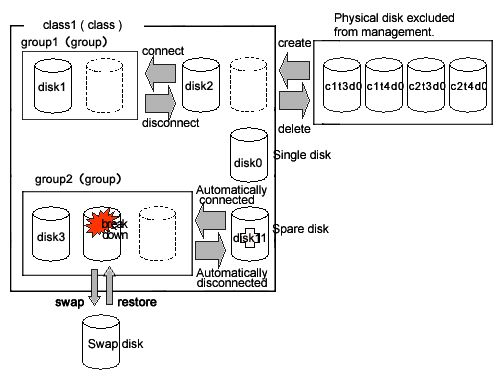Physical disks managed by GDS are registered with a certain class and are called SDX disks, or simply "disks."
Disks that no longer need to be managed with GDS can be deleted from the class and are returned to their original physical disk status.
Attributes
A disk has the following attributes.
This attribute identifies the disk within a class.
This attribute indicates the type of disk. Either of the following values will be set.
The disk has been connected to a mirror group.
The disk has been connected to a stripe group.
The disk has been connected to a concatenation group.
The disk is connected to a switch group.
Retains the disk format and data when registered with a class or connected to a group.
A volume can be created without connecting to a group.
The disk will be used as a spare disk.
The disk has been registered with the class without its usage being specified.
Operation
The following operations are available for disks.
A disk can be created by registering a physical disk with a certain class, using the sdxdisk -M command.
For details on GDS Management View, see "5.2.3.1 Class Configuration."
A disk can be deleted from a class with the sdxdisk -R command.
For details on GDS Management View, see "5.5.3 Removing a Class."
A disk can be added to a certain group with the sdxdisk -C command.
For details on GDS Management View, see "5.4.2 Group Configuration."
A disk can be disconnected from the group with the sdxdisk -D command.
For details on GDS Management View, see "5.4.2 Group Configuration."
A disk is made ready for disk swap with the sdxswap -O command.
For details on GDS Management View, see "5.3.4 Disk Swap."
Swapped disks can be recovered with the sdxswap -I command.
For details on GDS Management View, see "5.3.4 Disk Swap."
The disk status can be displayed with the sdxinfo command.
For details on GDS Management View, see "5.3.1 Viewing Configurations/Statuses and Monitoring Statuses."
Disk attribute values can be changed with the sdxattr -D command.
For details on GDS Management View, see "5.4.1 Class Configuration."
The I/O error status of SDX disks can be cleared with the sdxfix -D command.
The operation from GDS Management View is unsupported.
Status
A disk can have the following status.
The disk is in the normal status.
Unless you conduct a special operation, or a special event occurs, a disk is usually in the ENABLE status.
Since disk identification information (class and disk names) is not set, data on the disk is inaccessible.
When disk identification information stored in the private slice of a disk is not set at the time of booting the system, the disk will be in DISABLE status. For example, if a user reboots the system after formatting a disk mistakenly, it will be in this status. If this happens, all slices related to the disk are made the NOUSE status.
For details when the disk is in DISABLE status, see "F.1.2 Disk Status Abnormality."
Data on the disk is inaccessible and the disk is ready for disk swap.
Successful completion of the sdxswap -O command will make the disk the SWAP status. If this happens, all slices related to the disk are made the NOUSE status.
Reference
There are the following points of concern for disks.
A.2.3 Restraining Access to Physical Special File
A.2.16 Swapping Physical Disks
Figure 2.3 SDX Disk
